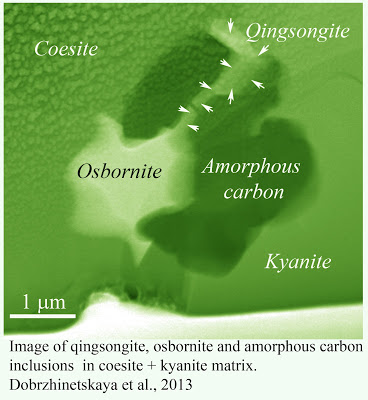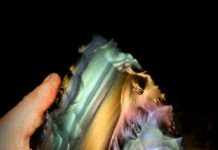
Geologists at the University of California, Riverside have discovered a new mineral, cubic boron nitride, which they have named “qingsongite.”
The discovery, made in 2009, was officially approved this week by the International Mineralogical Association.
The UC Riverside geologists, Larissa Dobrzhinetskaya and Harry Green in the Department of Earth Sciences, were joined by scientists at the Lawrence Livermore National Laboratory, the University of Maine and from institutions in China and Germany in making the discovery.
“The uniqueness of qingsongite is that it is the first boron mineral that was found to be formed at extreme conditions in deep Earth,” Dobrzhinetskaya said. “All other known boron minerals are found at Earth’s surface.”
The mineral was found in the southern Tibetan mountains of China within chromium-rich rocks of the paleooceanic crust that was subducted to a depth of 190 miles and recrystallized there at a temperature of about 2372 degrees Fahrenheit and pressure of about 118430 atmospheres.
“About 180 million years ago the rocks were returned back to shallow levels of the Earth by plate tectonic processes leading to the closure of the huge Paleo-Thethys ocean — an ancient Paleozoic ocean — and the collision of India with the Asian lithospheric plate,” Dobrzhinetskaya explained.
Until now, cubic boron nitride, created first in the laboratory in 1957, was known as an important technological material. Because its atomic structure bears resemblance to carbon bonds in diamond, it has high density and could be as hard as diamond.
Over 4,700 species of minerals have been recognized to date, and nowadays at least 100 proposals for new minerals and their names are submitted each year for approval by the Commission on New Minerals, Nomenclature and Classification of the International Mineralogical Association, which was founded in 1958. Commission members, who represent 34 countries including the U.S., vote separately on each new mineral and its name.
Qingsongite was named after Qingsong Fang (1939–2010), a professor at the Institute of Geology, the Chinese Academy of Geological Sciences, who found the first diamond in the Tibetan chromium-rich rocks in the late 1970s, and contributed to the discovery of four new mineral species.
The scientific project that led to the discovery of qingsongite was supported by grants from the University of California Laboratory Fees Research Program and the National Science Foundation.
Note : The above story is based on materials provided by University of California










